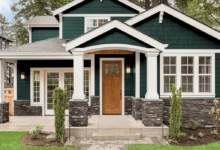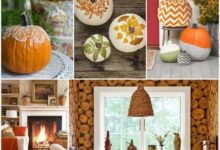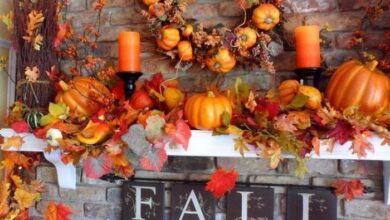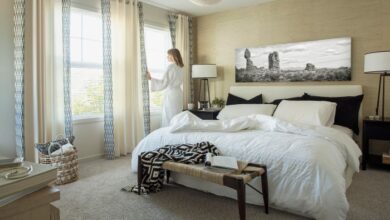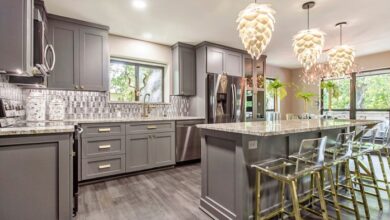Home Exterior Shutters A Complete Guide
Home Exterior Shutters: More than just a pretty face, they significantly impact your home’s curb appeal, energy efficiency, and even security. This guide dives deep into the world of exterior shutters, exploring the diverse materials, styles, functionalities, and installation processes involved. We’ll cover everything from choosing the right material and style to budgeting for your project and maintaining your shutters for years to come.
Get ready to transform your home’s exterior!
From classic board and batten to modern louvered designs, the options are vast. We’ll help you navigate the choices, considering factors like your home’s architectural style, your budget, and your desired level of maintenance. Understanding the role of shutters in enhancing energy efficiency, improving security, and boosting curb appeal is crucial, and this guide provides all the information you need to make informed decisions.
Types of Home Exterior Shutters
Choosing the right exterior shutters can significantly enhance your home’s curb appeal and provide added functionality. The selection process involves considering various factors, including material, style, and maintenance requirements. This section will delve into the different types of shutters available, highlighting their pros and cons to aid in your decision-making.
Shutter Materials
Exterior shutters are crafted from a variety of materials, each possessing unique properties affecting their durability, aesthetics, and cost.
Wood Shutters: These offer a classic, timeless look and can be painted or stained to match any home style. However, wood requires regular maintenance to prevent rotting, warping, and insect damage. It’s also susceptible to weathering and requires more upkeep than other materials. High-quality wood, like cedar or redwood, is naturally more resistant to the elements and offers a longer lifespan.
Vinyl Shutters: Vinyl shutters are a popular choice due to their affordability and low maintenance. They are resistant to moisture, insects, and rot, making them a durable option for various climates. However, they can be less aesthetically pleasing than wood, potentially appearing less refined, and are prone to cracking or fading under extreme temperature fluctuations. They also lack the same level of customization as wood.
Composite Shutters: Composite shutters combine different materials, often wood fibers and polymers, to create a product with the look of wood but enhanced durability and weather resistance. These shutters offer a good balance between aesthetics and practicality, requiring less maintenance than wood while retaining a more natural appearance. However, they can be more expensive than vinyl.
Choosing the right home exterior shutters can dramatically improve your curb appeal. However, thinking about energy efficiency also matters, and that’s where the innovative use of technology comes in; for example, learn more about how Blockchain in renewable energy is increasing transparency and traceability in the sector. Ultimately, efficient shutters contribute to lower energy bills, complementing the broader sustainable goals.
Aluminum Shutters: Aluminum shutters are lightweight, durable, and resistant to rust and corrosion. They are also relatively inexpensive and easy to install. However, they can dent easily and may not offer the same aesthetic appeal as wood or composite shutters. Their lightweight nature can also make them susceptible to strong winds.
Shutter Styles
The visual impact and functionality of your shutters are largely determined by their style. Different styles complement various architectural designs and offer varying degrees of light control and privacy.
Board and Batten Shutters: These shutters feature wide vertical boards with narrower battens covering the joints. They provide a clean, traditional look and are suitable for a range of architectural styles. They offer good light and privacy control when closed.
Choosing the right home exterior shutters can dramatically improve your curb appeal. But have you considered how your energy consumption impacts the environment? Reducing your carbon footprint is important, and you might explore alternative energy sources like those described in this article on wind turbines for small businesses , which could even help offset the cost of those beautiful new shutters! Ultimately, both sustainable practices and attractive home features contribute to a better overall quality of life.
Raised Panel Shutters: These shutters have recessed panels, creating a three-dimensional effect that adds visual interest. They offer a more formal and elegant appearance and are often found on homes with traditional or craftsman styles. Functionality is similar to board and batten.
Louvered Shutters: These shutters consist of horizontal slats, allowing for adjustable light and ventilation control. They offer a more contemporary look and are particularly useful in warmer climates where airflow is desired. The adjustable slats allow for fine-tuning of light and privacy.
Other styles, such as colonial shutters (often featuring a wider top panel than bottom), cavalier shutters (with decorative molding), and shutter styles with decorative cutouts offer additional aesthetic options. The choice depends on personal preference and architectural style.
Shutter Maintenance Comparison
| Material | Cleaning | Repair | Lifespan |
|---|---|---|---|
| Wood | Regular cleaning with mild soap and water; occasional staining or painting | Can be repaired with wood filler and paint; may require professional assistance for significant damage | 20-50+ years (depending on wood type and maintenance) |
| Vinyl | Simple cleaning with soap and water; occasional power washing | Difficult to repair; often requires replacement of damaged sections | 15-30 years |
| Composite | Cleaning with soap and water; occasional power washing | Repair may be possible depending on the damage; often requires professional assistance | 20-40 years |
| Aluminum | Easy cleaning with soap and water; occasional power washing | Repair may involve replacing damaged sections; relatively easy to repair | 20-30 years |
Shutter Functionality and Features: Home Exterior Shutters
Home exterior shutters offer far more than just curb appeal; they provide a range of practical benefits impacting energy efficiency, aesthetics, and even home security. Understanding these features allows homeowners to make informed decisions when selecting and installing shutters.
Shutters play a significant role in enhancing a home’s energy efficiency. Their ability to act as an extra layer of insulation helps regulate indoor temperatures, reducing the strain on heating and cooling systems. During summer, closed shutters prevent direct sunlight from heating interior spaces, thus lowering the need for air conditioning. Conversely, in winter, closed shutters create an insulating barrier against cold winds, minimizing heat loss and reducing reliance on heating.
This translates to lower energy bills and a smaller carbon footprint.
Shutter Energy Efficiency, Home Exterior Shutters
The impact of shutters on energy efficiency depends on several factors. Material plays a crucial role; thicker, denser materials like solid wood provide better insulation than thinner materials like vinyl or composite. The color of the shutter also influences its ability to reflect or absorb heat. Lighter colors reflect more sunlight, keeping the home cooler, while darker colors absorb more heat.
The proper fit and seal of the shutters against the window frame is equally important to minimize air leakage.
Shutter Aesthetics and Design
Shutter color and size significantly impact a home’s overall aesthetic. The color choice should complement the house’s exterior paint, architectural style, and landscaping. For instance, a traditional colonial home might look stunning with dark green or black shutters, while a modern home might benefit from clean white or gray shutters. Shutter size also matters; proportionally sized shutters enhance the home’s visual balance, while oversized or undersized shutters can appear jarring.
Home exterior shutters can dramatically change your curb appeal, and autumn is the perfect time to refresh their look. For inspiration on coordinating colors and styles, check out this article on Designer-Approved Autumn Decor for ideas on bringing those warm autumnal hues to your home’s exterior. Then, you can choose shutter colors that complement your updated autumnal decor perfectly, creating a cohesive and stylish look.
The style of the shutter itself – louvered, raised panel, board and batten – also contributes to the overall look and should align with the home’s architectural style.
Shutter Security Enhancements
Shutters can add an extra layer of security to a home. Solid, well-constructed shutters act as a deterrent to potential intruders. While not impenetrable, they make it more difficult to break a window or gain entry through a vulnerable point. The added physical barrier can slow down potential burglars, giving time for emergency services to respond. Consider shutters with strong locking mechanisms for enhanced security in high-risk areas.
Shutter Operating Mechanisms
Shutters are available in various operating mechanisms, each offering different levels of convenience and functionality. Hinged shutters are the most common type, swinging open and closed like a door. Sliding shutters move horizontally along a track, while folding shutters consist of multiple panels that fold together for compact storage. The choice of operating mechanism depends on personal preference, accessibility needs, and the overall design of the home.
For instance, hinged shutters might be more suitable for larger windows, while sliding shutters might be preferred for smaller windows or where space is limited.
Shutter Installation and Maintenance
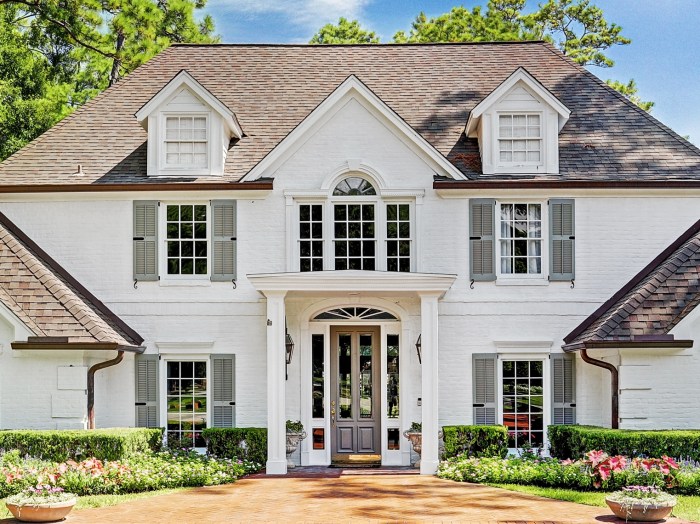
Source: theshadeshop.net
Installing and maintaining your exterior shutters properly ensures their longevity and enhances your home’s curb appeal. This section provides a comprehensive guide to installation, measurement, cleaning, and repair, covering various shutter materials.
Choosing the right home exterior shutters can dramatically improve your curb appeal. As the leaves change, you might also be thinking about updating your interior, so check out this guide for Best Fall Furniture to complement your newly enhanced exterior. Once you’ve got the inside cozy, you’ll truly appreciate the stunning look of your freshly painted shutters and the overall autumnal ambiance.
Shutter Installation: A Step-by-Step Guide
Proper installation is crucial for both the aesthetic and functional aspects of your shutters. Incorrect installation can lead to damage, poor performance, and even security vulnerabilities. Following these steps will help ensure a successful installation.
- Preparation: Gather your tools (measuring tape, level, drill, screws, caulk, safety glasses, work gloves), shutters, and any necessary hardware. Ensure the area around the installation site is clear and safe.
- Measurement and Marking: Accurately measure the window or door opening. Consider the desired shutter overlap and add this measurement to the total width. Mark the location of the shutter mounting brackets on the wall using a level to ensure they are perfectly aligned.
- Bracket Installation: Securely attach the mounting brackets to the wall using appropriate screws. Ensure the brackets are firmly fixed and level.
- Shutter Attachment: Carefully hang the shutters onto the installed brackets. Adjust their position to ensure proper alignment and overlap.
- Securing and Finishing: Tighten all screws and apply caulk around the brackets to seal against moisture and drafts. Check for any gaps or misalignments and make necessary adjustments.
Measuring for Shutters: Ensuring Accuracy
Accurate measurements are paramount to a proper fit. Incorrect measurements can result in shutters that are too small, too large, or uneven.Imagine visualizing your window. Use a measuring tape to measure the width of the window frame at its widest point. Then, measure the height of the window frame from top to bottom. Add approximately 1-2 inches to both the width and height measurements to allow for proper overlap and a clean aesthetic appearance.
Take multiple measurements at different points to ensure accuracy. If the window has any trim or molding, factor this into your measurements. Record all measurements carefully and double-check them before purchasing your shutters.
Shutter Cleaning and Maintenance
Regular cleaning and maintenance extend the life of your shutters. The cleaning method will vary depending on the material.
- Wood Shutters: Use a soft brush or cloth to remove loose dirt and debris. For more stubborn dirt, use a mild soap and water solution, rinsing thoroughly afterward. Avoid using harsh chemicals or abrasive cleaners. Periodically apply a high-quality wood sealant or varnish to protect against the elements.
- Vinyl Shutters: Vinyl shutters are generally low-maintenance. Clean them with a mild soap and water solution and a soft brush or sponge. Rinse thoroughly and allow them to air dry. Avoid using abrasive cleaners or high-pressure water.
- Aluminum Shutters: Similar to vinyl, aluminum shutters are easy to clean. Use a mild soap and water solution and a soft cloth or sponge. Rinse thoroughly and allow to air dry.
Repairing Common Shutter Problems
Addressing minor issues promptly prevents them from escalating into larger, more costly repairs.Loose hinges are a common problem. Tighten loose screws or replace damaged screws with longer or stronger ones. If the hinge itself is damaged, it may need to be replaced. For damaged panels, depending on the material and extent of the damage, you may be able to repair the damage with wood filler (for wood shutters), or you may need to replace the entire panel.
Always use appropriate safety precautions when working with tools.
Shutter Design and Architectural Styles
Shutters, far from being merely functional window coverings, are significant design elements that contribute substantially to a home’s architectural style and curb appeal. Their style, material, and placement can dramatically alter the overall aesthetic, reflecting the historical period and design principles of the house. Choosing the right shutters involves understanding how different styles complement various architectural designs.
The interplay between shutter design and architectural style is crucial for achieving a cohesive and visually appealing exterior. Certain shutter styles are inherently more compatible with particular architectural periods than others. For example, the elaborate detailing often found on Victorian shutters would clash with the clean lines of a modern home. Conversely, simple, board-and-batten shutters would feel out of place on a grand, ornate Georgian mansion.
Careful consideration of these stylistic nuances ensures a harmonious and historically accurate look.
Shutter Styles in Different Architectural Contexts
The use of shutters varies significantly across different architectural styles. Victorian homes, known for their ornate detailing and asymmetry, often feature wide, louvered shutters with decorative trim, sometimes even featuring elaborate carvings or painted designs. Colonial homes, in contrast, frequently utilize simpler, six-panel or raised-panel shutters, reflecting the era’s emphasis on symmetry and practicality. Craftsman-style homes, with their emphasis on natural materials and handcrafted details, might incorporate simpler, board-and-batten shutters or those with a slightly more rustic aesthetic.
Modern homes often feature minimalist shutters, possibly in clean lines and neutral colors, to maintain a contemporary look.
Design Elements Contributing to Shutter Aesthetic Appeal
Several design elements significantly impact the aesthetic appeal of shutters within a specific architectural context. These include:
- Shutter Style: The type of shutter (louvered, raised panel, board and batten) dramatically influences the overall appearance. Louvered shutters offer light control and a classic look, while raised panel shutters provide a more formal and traditional feel. Board and batten shutters lend a rustic charm.
- Shutter Material: The material—wood, vinyl, composite—affects both the appearance and durability. Wood shutters offer a classic, high-end look but require more maintenance. Vinyl shutters are more affordable and low-maintenance, while composite materials provide a balance of aesthetics and durability.
- Shutter Color: Color plays a critical role in the overall aesthetic. Complementing the home’s exterior color is key. A contrasting color can create a striking visual effect, while a matching or subtly different shade provides a more unified look.
- Shutter Size and Proportion: The size and proportion of the shutters relative to the windows are crucial. Shutters that are too large or too small can look disproportionate and detract from the overall design.
- Hardware and Trim: Details such as hinges, latches, and decorative trim can add significant visual interest and contribute to the overall style. These elements should be carefully chosen to complement the architectural style of the home.
Shutter Design Examples for Different Exterior Materials
The following examples illustrate how shutter design can complement various exterior materials:
- Brick Home: Imagine a traditional brick home with dark red bricks. Wide, raised-panel shutters painted a deep forest green would create a striking contrast, highlighting the architectural details. Black or dark bronze hinges and latches would further enhance the sophisticated look. The deep green complements the red brick while adding a touch of formality.
- Siding Home: A home with light gray vinyl siding could be beautifully complemented by board-and-batten shutters in a creamy white or soft gray-blue. This creates a cohesive and calming aesthetic. Simple, black hinges and latches would provide a subtle contrast without overpowering the overall palette. The slightly off-white color maintains a sense of unity with the siding while adding subtle visual interest.
- Stucco Home: A stucco home in a warm beige tone could benefit from louvered shutters in a terracotta or burnt orange hue. This choice enhances the warm, earthy tones of the stucco. Matching or slightly darker bronze hardware would create a cohesive and elegant look. The terracotta complements the stucco, creating a unified Mediterranean or Southwestern feel.
Cost and Budgeting for Shutters
Installing exterior shutters can significantly enhance your home’s curb appeal and value, but it’s crucial to understand the associated costs before embarking on the project. Several factors influence the overall expense, from the materials chosen to the complexity of the installation. Careful budgeting ensures a smooth and financially responsible process.
The total cost of your shutter project will be determined by a combination of material costs, labor costs, and any additional expenses. Material costs vary widely depending on the type of material, size, and style of shutter you select. Labor costs depend on the number of shutters, their size and complexity of installation, and your location. Additional expenses might include permits, paint or stain, and any necessary repairs to the existing window frames before installation.
Shutter Material and Style Costs
The following table provides an estimated cost range for different shutter materials and styles. Keep in mind that these are averages and can fluctuate based on factors such as location, supplier, and customization options. Always obtain multiple quotes from reputable contractors to get a clearer picture of the costs in your specific area.
| Style | Material | Average Cost per Shutter | Installation Cost per Shutter |
|---|---|---|---|
| Board and Batten | Wood | $100 – $300 | $50 – $100 |
| Raised Panel | Wood | $150 – $400 | $50 – $100 |
| Louvered | Wood | $75 – $250 | $50 – $100 |
| Louvered | Vinyl | $50 – $150 | $30 – $75 |
| Board and Batten | Vinyl | $75 – $200 | $30 – $75 |
| Composite | Fiber Cement | $200 – $500 | $75 – $150 |
Budgeting Tips and Cost-Effective Solutions
Effective budgeting is key to a successful shutter installation. Consider these tips to manage costs effectively:
First, accurately measure your windows to determine the number and size of shutters needed. This prevents over- or under-ordering materials. Second, shop around and compare prices from multiple suppliers before making any purchases. Don’t hesitate to negotiate for better deals. Third, consider DIY installation if you have the skills and tools; this can significantly reduce labor costs.
However, weigh the potential savings against the risk of improper installation. Fourth, explore cost-effective material options like vinyl or composite materials, which are durable and often more affordable than wood. Fifth, plan your project during the off-season (typically fall or winter) when contractors may offer lower rates.
For example, choosing vinyl shutters instead of wood can save you hundreds of dollars, especially on larger projects. A homeowner installing shutters on ten windows could save several hundred dollars by opting for vinyl over wood, factoring in both material and potential labor cost savings if they choose to DIY the installation of the less expensive option. Similarly, installing shutters during the winter months might result in a 10-15% discount on labor costs compared to peak seasons.
Last Point
Ultimately, choosing and installing home exterior shutters is a rewarding investment that enhances both the aesthetic and functional aspects of your home. By carefully considering the various factors discussed—material, style, functionality, and cost—you can select shutters that perfectly complement your home’s architecture and lifestyle. Remember, the right shutters can dramatically increase your home’s value and provide years of beauty and protection.
So, take the plunge and let your home shine!
Quick FAQs
What is the best time of year to install exterior shutters?
Spring or fall are generally ideal, avoiding extreme heat or cold that can affect installation and paint drying.
Can I install shutters myself?
While possible for some, professional installation is often recommended, especially for larger or more complex projects, ensuring a proper fit and longevity.
How often should I clean my shutters?
Frequency depends on the material and climate. A yearly cleaning is a good starting point, more often if needed.
Do shutters really improve home security?
Yes, they can act as a deterrent to potential intruders and provide an extra layer of protection, especially when paired with strong locks and other security measures.
What are the warranty options for exterior shutters?
Warranties vary greatly depending on the manufacturer and material. Check the manufacturer’s specifications for details.
